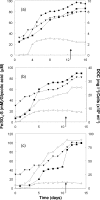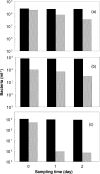Production of glycolic acid by chemolithotrophic iron- and sulfur-oxidizing bacteria and its role in delineating and sustaining acidophilic sulfide mineral-oxidizing consortia
- PMID: 19933342
- PMCID: PMC2805229
- DOI: 10.1128/AEM.01832-09
Production of glycolic acid by chemolithotrophic iron- and sulfur-oxidizing bacteria and its role in delineating and sustaining acidophilic sulfide mineral-oxidizing consortia
Abstract
Glycolic acid was detected as an exudate in actively growing cultures of three chemolithotrophic acidophiles that are important in biomining operations, Leptospirillum ferriphilum, Acidithiobacillus (At.) ferrooxidans, and At. caldus. Although similar concentrations of glycolic acid were found in all cases, the concentrations corresponded to ca. 24% of the total dissolved organic carbon (DOC) in cultures of L. ferriphilum but only ca. 5% of the total DOC in cultures of the two Acidithiobacillus spp. Rapid acidification (to pH 1.0) of the culture medium of At. caldus resulted in a large increase in the level of DOC, although the concentration of glycolic acid did not change in proportion. The archaeon Ferroplasma acidiphilum grew in the cell-free spent medium of At. caldus; glycolic acid was not metabolized, although other unidentified compounds in the DOC pool were metabolized. Glycolic acid exhibited levels of toxicity with 21 strains of acidophiles screened similar to those of acetic acid. The most sensitive species were chemolithotrophs (L. ferriphilum and At. ferrivorans), while the most tolerant species were chemoorganotrophs (Acidocella, Acidobacterium, and Ferroplasma species), and the ability to metabolize glycolic acid appeared to be restricted (among acidophiles) to Firmicutes (chiefly Sulfobacillus spp.). Results of this study help explain why Sulfobacillus spp. rather than other acidophiles are the main organic carbon-degrading bacteria in continuously fed stirred tanks used to bioprocess sulfide mineral concentrates and also why temporary cessation of pH control in these systems, resulting in rapid acidification, often results in a plume of the archaeon Ferroplasma.
Figures




Similar articles
-
Biooxidation of pyrite by defined mixed cultures of moderately thermophilic acidophiles in pH-controlled bioreactors: significance of microbial interactions.Biotechnol Bioeng. 2004 Sep 5;87(5):574-83. doi: 10.1002/bit.20138. Biotechnol Bioeng. 2004. PMID: 15352055
-
Automated Microscopic Analysis of Metal Sulfide Colonization by Acidophilic Microorganisms.Appl Environ Microbiol. 2018 Oct 1;84(20):e01835-18. doi: 10.1128/AEM.01835-18. Print 2018 Oct 15. Appl Environ Microbiol. 2018. PMID: 30076195 Free PMC article.
-
Growth of Leptospirillum ferriphilum in sulfur medium in co-culture with Acidithiobacillus caldus.Extremophiles. 2018 Mar;22(2):327-333. doi: 10.1007/s00792-018-1001-3. Epub 2018 Jan 12. Extremophiles. 2018. PMID: 29330649 Free PMC article.
-
Genomic insights into microbial iron oxidation and iron uptake strategies in extremely acidic environments.Environ Microbiol. 2012 Jul;14(7):1597-611. doi: 10.1111/j.1462-2920.2011.02626.x. Epub 2011 Nov 3. Environ Microbiol. 2012. PMID: 22050575 Review.
-
Acidophiles in bioreactor mineral processing.Extremophiles. 2000 Apr;4(2):71-6. doi: 10.1007/s007920050139. Extremophiles. 2000. PMID: 10805560 Review.
Cited by
-
A Novel Inorganic Sulfur Compound Metabolizing Ferroplasma-Like Population Is Suggested to Mediate Extracellular Electron Transfer.Front Microbiol. 2018 Dec 5;9:2945. doi: 10.3389/fmicb.2018.02945. eCollection 2018. Front Microbiol. 2018. PMID: 30568637 Free PMC article.
-
In-depth characterization via complementing culture-independent approaches of the microbial community in an acidic hot spring of the Colombian Andes.Microb Ecol. 2012 Jan;63(1):103-15. doi: 10.1007/s00248-011-9943-3. Epub 2011 Sep 27. Microb Ecol. 2012. PMID: 21947461
-
Selective removal of transition metals from acidic mine waters by novel consortia of acidophilic sulfidogenic bacteria.Microb Biotechnol. 2012 Jan;5(1):34-44. doi: 10.1111/j.1751-7915.2011.00285.x. Epub 2011 Sep 6. Microb Biotechnol. 2012. PMID: 21895996 Free PMC article.
-
Diffusible signal factor signaling controls bioleaching activity and niche protection in the acidophilic, mineral-oxidizing leptospirilli.Sci Rep. 2021 Aug 11;11(1):16275. doi: 10.1038/s41598-021-95324-9. Sci Rep. 2021. PMID: 34381075 Free PMC article.
-
Microalgae-bacteria biofilms: a sustainable synergistic approach in remediation of acid mine drainage.Appl Microbiol Biotechnol. 2018 Feb;102(3):1131-1144. doi: 10.1007/s00253-017-8693-7. Epub 2017 Dec 19. Appl Microbiol Biotechnol. 2018. PMID: 29260261 Review.
References
-
- Aliaga Goltsman, D. S., V. J. Denef, S. W. Singer, N. C. VerBerkmoes, M. Lefsrud, R. S. Mueller, G. J. Dick, C. L. Sun, K. E. Wheeler, A. Zemla, B. J. Baker, L. Hauser, M. Land, M. B. Shah, M. P. Thelen, R. L. Hettich, and J. F. Banfield. 2009. Community genomic and proteomic analysis of chemoautotrophic iron-oxidizing “Leptospirillum rubarum” (group II) and “Leptospirillum ferrodiazotrophum (group III) bacteria in acid mine drainage biofilms. Appl. Environ. Microbiol. 75:4599-4615. - PMC - PubMed
-
- Bridge, T. A. M., and D. B. Johnson. 2000. Reductive dissolution of ferric iron minerals by Acidiphilium SJH. Geomicrobiol. J. 17:193-206.
-
- Brierley, J. A., P. R. Norris, D. P. Kelly, and N. W. Le Roux. 1978. Characteristics of a moderately thermophilic and acidophilic iron-oxidizing Thiobacillus. Eur. J. Appl. Microbiol. Biotechnol. 5:291-299.
Publication types
MeSH terms
Substances
LinkOut - more resources
Full Text Sources
Medical
Miscellaneous

